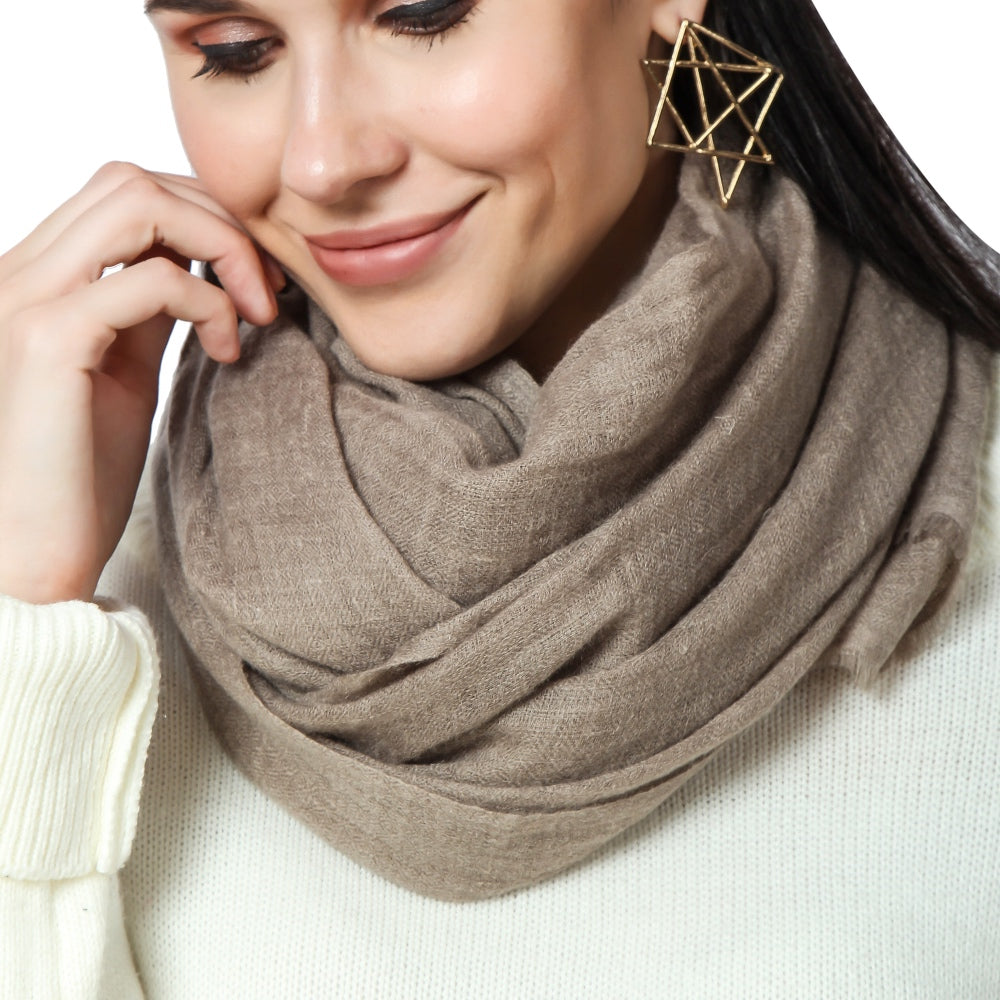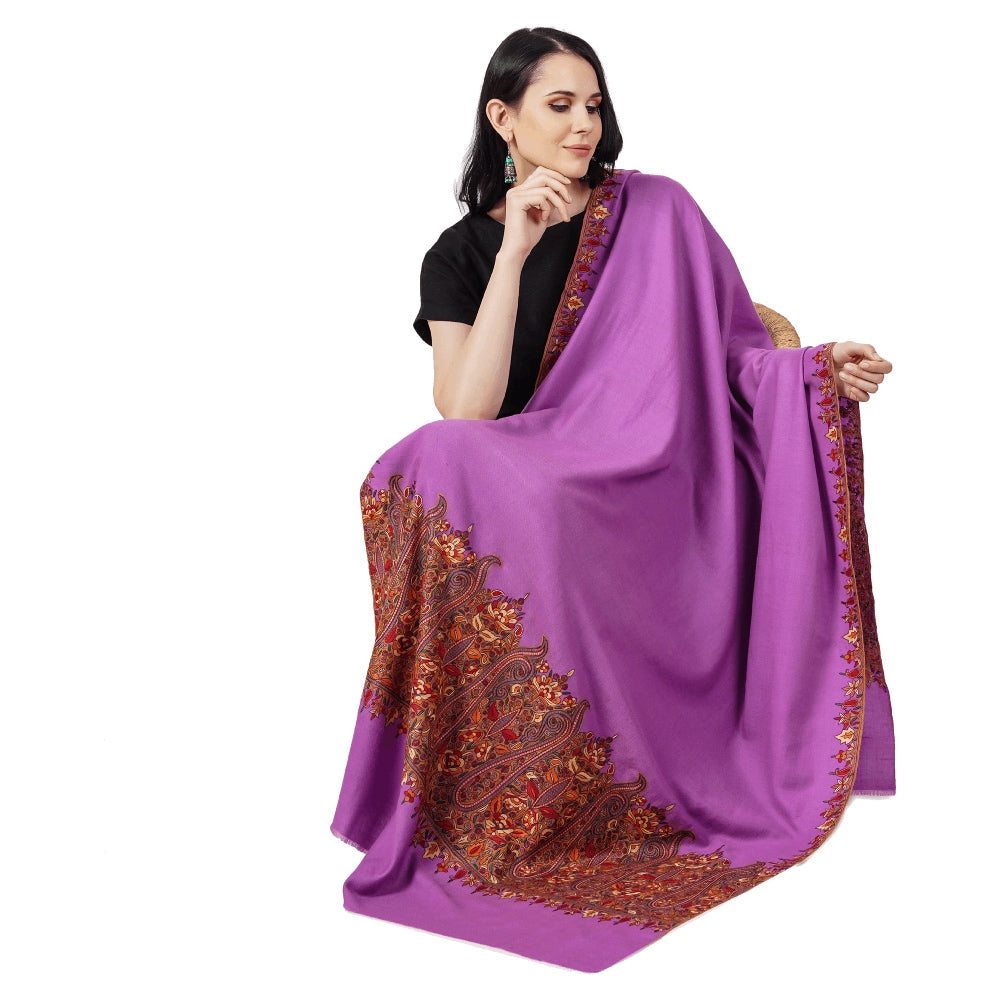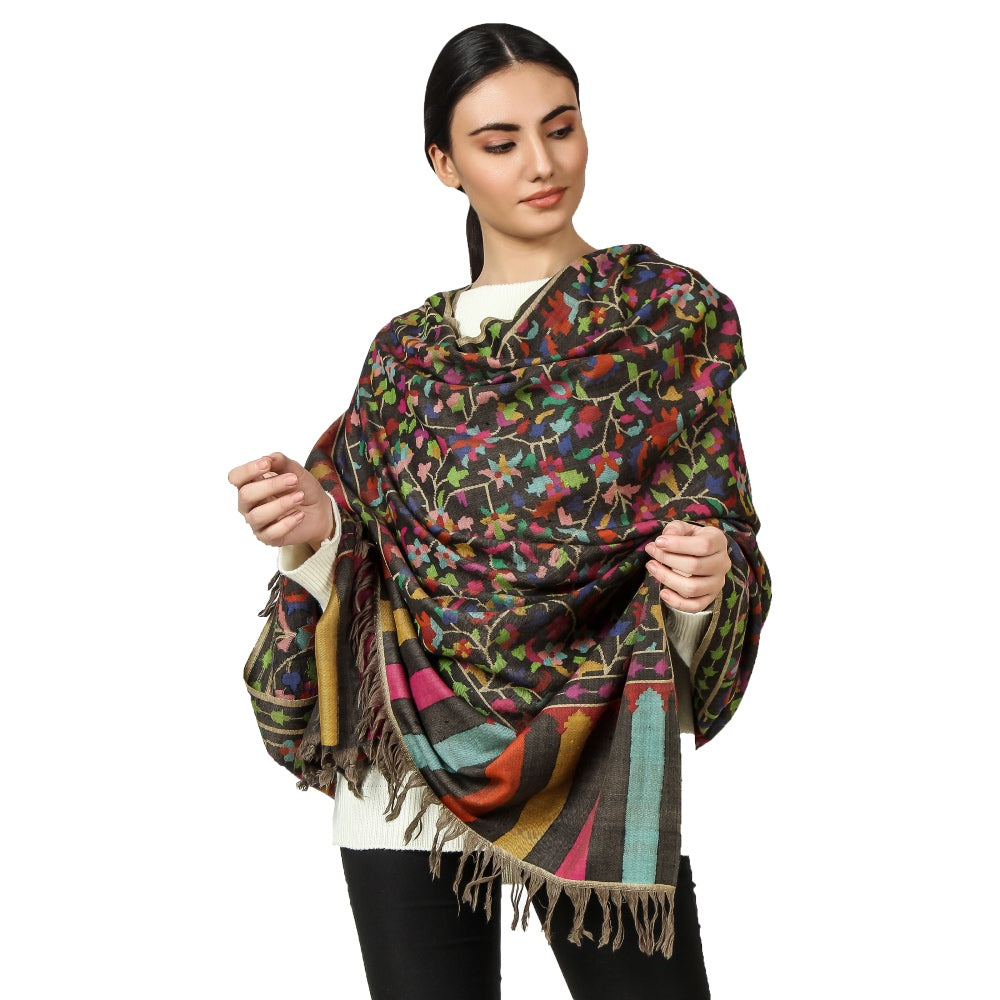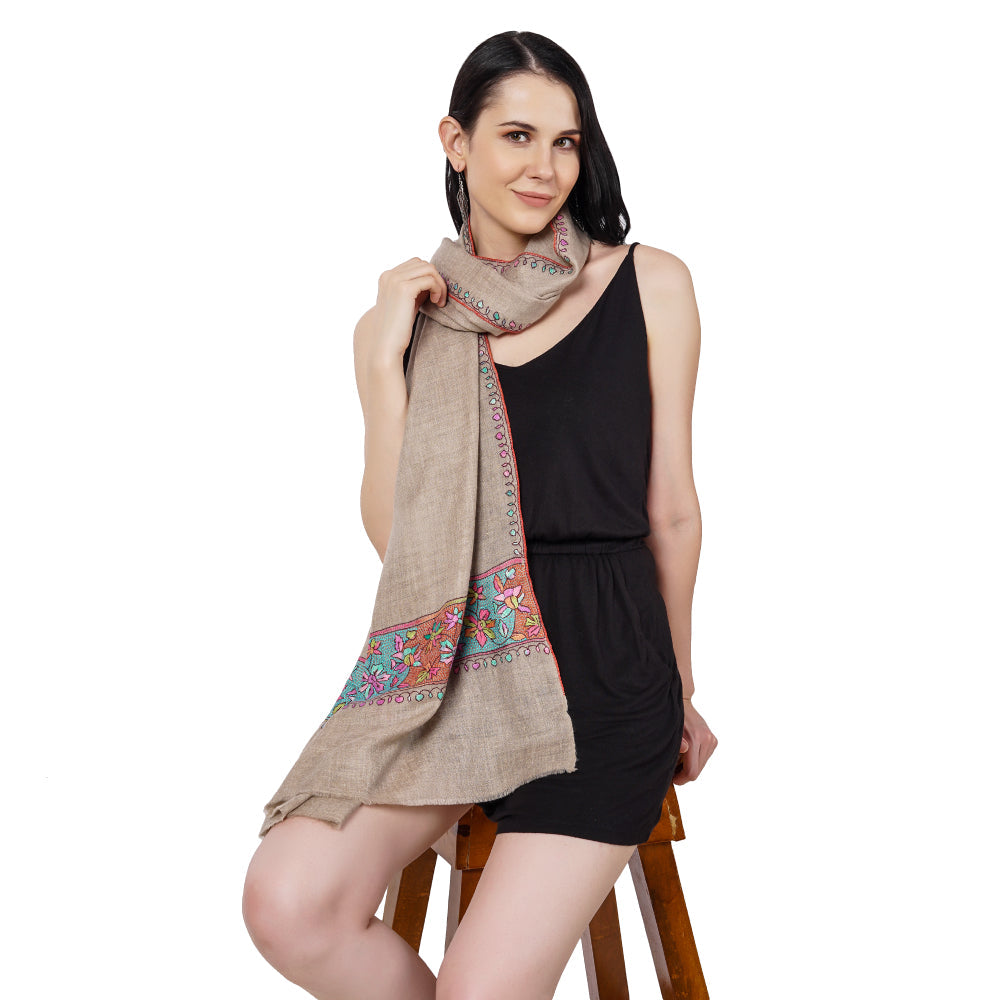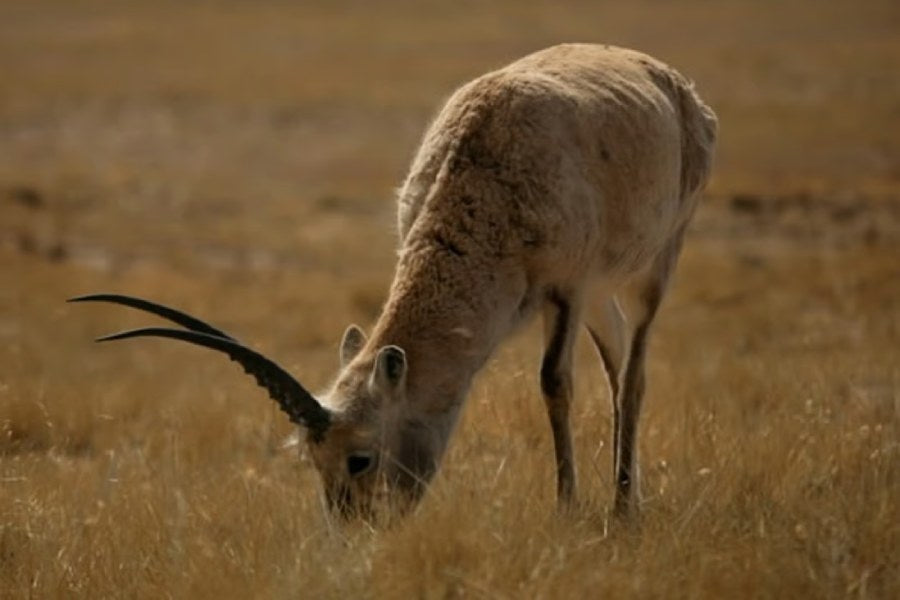
Shahtoosh vs Pashmina: Understanding the Differences and Similarities
Share
Shahtoosh and Pashmina are two luxury fabrics that are highly prized for their softness, warmth, and quality. Shahtoosh is a fabric that is made from the wool of the Tibetan antelope, while Pashmina is made from the wool of the Cashmere goat. Both fabrics are known for their exceptional softness and lightweight, making them highly sought-after materials for high-end fashion accessories such as scarves, shawls, and wraps.
Shahtoosh has a long and storied history, with some of the earliest known references to the fabric dating back to the 3rd century BCE. The wool of the Tibetan antelope was highly prized by ancient Indian kings, who valued its softness and warmth. Pashmina, on the other hand, has been produced in the Kashmir region of India for centuries. The wool of the Cashmere goat was highly valued by the Mughal emperors of India, who used it to create luxurious clothing and accessories.
Today, Shahtoosh and Pashmina continue to be highly prized materials, with demand coming from all over the world. Both fabrics are known for their exceptional softness and warmth, and are often used to create high-end fashion accessories such as scarves, shawls, and wraps. While Shahtoosh is highly prized for its rarity and exclusivity, Pashmina is more widely available and is a popular choice for those looking for a luxurious and high-quality fabric. Despite their high price tags, Shahtoosh and Pashmina remain popular with fashion-conscious consumers who are willing to pay a premium for the best quality materials.
Shahtoosh
Shahtoosh is a luxury fabric that is made from the wool of the Tibetan antelope. The wool is extremely fine and lightweight, which makes it highly prized for creating high-end fashion accessories such as shawls, scarves, and wraps. Shahtoosh fabric is known for its softness and warmth, and is considered to be one of the most luxurious fabrics in the world.

Sources and production
The wool for Shahtoosh fabric is obtained from the Tibetan antelope, which is also known as the chiru. These antelopes are found in the high-altitude regions of the Tibetan plateau and are highly protected. The production of Shahtoosh fabric is a highly specialized and time-consuming process. Each shawl requires the wool of several antelopes, which makes it an extremely rare and expensive material.
Characteristics and qualities
Shahtoosh fabric is extremely lightweight, which makes it ideal for creating high-end fashion accessories such as scarves and shawls. It is also known for its softness and warmth, which makes it highly sought-after by luxury fashion designers and consumers. Shahtoosh is also highly breathable, which makes it comfortable to wear in a variety of different climates.
Popularity and demand
Despite its high price tag, Shahtoosh remains popular with luxury fashion designers and consumers who are willing to pay a premium for the best quality materials. Its rarity and exclusivity only add to its appeal, and it is often considered to be a status symbol among the fashion-conscious elite. However, due to the high demand for Shahtoosh, the production of the fabric has had a significant impact on the population of the Tibetan antelope, which is listed as an endangered species.
Legal status
Due to the endangered status of the Tibetan antelope, the trade and production of Shahtoosh is illegal in many countries, including India and China. However, despite efforts to curb the trade of Shahtoosh, it continues to be produced and sold on the black market. As a result, many luxury fashion designers and consumers are actively seeking out sustainable alternatives to Shahtoosh fabric.
Pashmina
Pashmina is a luxury fabric that is made from the wool of the Cashmere goat. The wool is extremely soft, lightweight, and warm, making it highly prized for creating high-end fashion accessories such as shawls, scarves, and wraps. Pashmina is also known as Cashmere in many parts of the world.

Sources and production of Pashmina
Pashmina wool is obtained from the Cashmere goat, which is found primarily in the Himalayan region of India, Pakistan, and China. The wool is obtained by combing the undercoat of the goat, which is extremely fine and soft. The production of Pashmina is a highly specialized process that requires skilled artisans who can weave the wool into fine fabrics.
Also read: Which country produces best Quality Cashmere?
Characteristics and qualities of Pashmina
Pashmina is known for its softness, warmth, and lightweight, which makes it ideal for creating high-end fashion accessories. It is also highly breathable, which makes it comfortable to wear in a variety of different climates. Pashmina fabrics are available in a wide range of colors and designs, which makes them a popular choice for those who want to add a touch of luxury to their wardrobe.
Also read: How are pashmina Shawls made?
Popularity and demand of Pashmina
Pashmina has been a popular fabric for centuries, with demand coming from all over the world. Its softness and warmth have made it a favorite among luxury fashion designers and consumers, who are willing to pay a premium for the best quality materials. Pashmina scarves and shawls are often considered to be a status symbol, and are frequently seen on the red carpet and at high-end fashion events.
Legal status
Pashmina is a legal and sustainable alternative to Shahtoosh, which has been illegal to trade and produce in many countries due to the endangered status of the Tibetan antelope. The production of Pashmina is highly regulated in India and other countries, which helps to ensure that the animals are treated ethically and that the wool is obtained in a sustainable and humane manner.
Differences between Shahtoosh and Pashmina
Price:
Shahtoosh is one of the most expensive fabrics in the world due to its rarity and exclusivity. Its price can range from thousands to tens of thousands of dollars per piece, making it a luxury item that is only affordable to the wealthiest individuals. In contrast, Pashmina is still considered a high-end material, but it is more affordable than Shahtoosh and is accessible to a wider range of consumers.
Softness and texture:
Shahtoosh is known for its exceptional softness and fine texture, which is considered to be the finest in the world. Pashmina is also known for its softness, but its texture is slightly coarser than Shahtoosh. While both fabrics are soft and comfortable to wear, Shahtoosh is often considered to be more luxurious and delicate.
Durability:
Shahtoosh is a delicate fabric that requires special care to maintain its quality and durability. It is not as durable as Pashmina and is prone to damage from exposure to moisture, sunlight, and other environmental factors. Pashmina, on the other hand, is more durable and can withstand regular wear and tear.
Warmth and insulation:
Both Shahtoosh and Pashmina are known for their warmth and insulation properties, which make them ideal for cold weather. However, Shahtoosh is considered to be warmer than Pashmina due to its fine texture and the way it is woven.
Weaving and craftsmanship:
The process of weaving Shahtoosh is a highly specialized craft that requires skilled artisans who have been trained in the traditional techniques of weaving the fabric. Pashmina, on the other hand, can be produced using a variety of different techniques and is more accessible to a wider range of weavers and craftsmen. The craftsmanship and artistry involved in producing both Shahtoosh and Pashmina are highly valued and contribute to their overall quality and desirability.
Availability:
Shahtoosh is a rare and endangered material that is difficult to obtain legally. Due to the ban on its production and trade in many countries, it is only available through illegal channels or vintage collections. Pashmina, on the other hand, is more widely available and can be found in a variety of different styles and price ranges. While Pashmina is also a luxury item, it is not as exclusive as Shahtoosh and is more accessible to a wider range of consumers.
Comparison between Shahtoosh and Pashmina
A. Which is better?
Deciding whether Shahtoosh or Pashmina is better depends on a variety of factors, including personal preference and intended use. While Shahtoosh is known for its exceptional softness and warmth, it is also illegal to possess or trade due to the endangered status of the Tibetan antelope. On the other hand, Pashmina is a legal and widely available alternative that is also highly prized for its softness and warmth.
B. Factors to consider when choosing between Shahtoosh and Pashmina
When choosing between Shahtoosh and Pashmina, there are several factors to consider. Firstly, the legal status of Shahtoosh should be taken into consideration, as possession or trade of Shahtoosh can lead to severe legal consequences. Additionally, the intended use of the fabric should be considered, as Shahtoosh is much more delicate and prone to damage than Pashmina. Factors such as texture, warmth, and durability should also be taken into account, as Pashmina is known to be more durable and easier to care for than Shahtoosh. Lastly, price can also be a consideration, as Shahtoosh is much more expensive than Pashmina due to its rarity and illegal status. Ultimately, the decision between Shahtoosh and Pashmina will depend on individual preference and intended use.
How to identify Shahtoosh and Pashmina
Physical characteristics
Identifying Shahtoosh and Pashmina based on physical characteristics can be challenging, as they share many similarities in terms of texture and appearance. However, there are a few differences to look out for. Shahtoosh is typically softer and lighter than Pashmina, with a more delicate and transparent weave. Pashmina, on the other hand, is thicker and more opaque, with a slightly rougher texture than Shahtoosh. It is also common for Pashmina to have decorative embroidery, while Shahtoosh is usually left plain.
Price
Price can also be a factor in identifying Shahtoosh and Pashmina, as Shahtoosh is much more expensive than Pashmina due to its rarity and illegal status. If a shawl or scarf is being sold at an unusually high price, it may be an indicator that it is made from Shahtoosh rather than Pashmina.
Labels and certifications
One of the most reliable ways to identify whether a fabric is Shahtoosh or Pashmina is through labels and certifications. Genuine Pashmina products are often labeled as such, with the Pashmina certification mark indicating that the product is made from 100% pure Pashmina wool. Similarly, Shahtoosh products will often carry a certification mark indicating that they are made from the wool of the Tibetan antelope. It is important to note, however, that some counterfeit products may also carry false certification marks, so it is important to purchase from reputable and trusted sources.
How to identify Shahtoosh and Pashmina
Physical characteristics
Identifying Shahtoosh and Pashmina based on physical characteristics can be challenging, as they share many similarities in terms of texture and appearance. However, there are a few differences to look out for. Shahtoosh is typically softer and lighter than Pashmina, with a more delicate and transparent weave. Pashmina, on the other hand, is thicker and more opaque, with a slightly rougher texture than Shahtoosh. It is also common for Pashmina to have decorative embroidery, while Shahtoosh is usually left plain.
Price
Price can also be a factor in identifying Shahtoosh and Pashmina, as Shahtoosh is much more expensive than Pashmina due to its rarity and illegal status. If a shawl or scarf is being sold at an unusually high price, it may be an indicator that it is made from Shahtoosh rather than Pashmina.
Labels and certifications
One of the most reliable ways to identify whether a fabric is Shahtoosh or Pashmina is through labels and certifications. Genuine Pashmina products are often labeled as such, with the Pashmina certification mark indicating that the product is made from 100% pure Pashmina wool. Similarly, Shahtoosh products will often carry a certification mark indicating that they are made from the wool of the Tibetan antelope. It is important to note, however, that some counterfeit products may also carry false certification marks, so it is important to purchase from reputable and trusted sources.
Caring for Shahtoosh and Pashmina
A. Cleaning and washing
Taking care of Shahtoosh and Pashmina involves gentle cleaning and washing. It is important to avoid harsh chemicals or rough scrubbing that could damage the fibers. Hand-washing with lukewarm water and a mild detergent is the best way to clean them. After washing, gently squeeze out the water and lay the item flat to dry.
B. Storage
Proper storage is key to maintaining the quality of Shahtoosh and Pashmina. They should be stored in a clean, dry place, away from direct sunlight or moisture. To prevent moths from damaging the fabric, it is recommended to store them with cedar blocks or lavender sachets.
C. Maintenance
To keep Shahtoosh and Pashmina looking their best, they should be brushed regularly with a soft-bristled brush to remove any dust or debris. Avoid using a clothes steamer or iron as the heat can damage the delicate fibers. Instead, steam lightly by holding the item above a pot of boiling water.
Shahtoosh and Pashmina in Fashion
A. Traditional uses
Shahtoosh and Pashmina have been used in traditional fashion for centuries. In India, the Kashmiri shawl, made of Pashmina, has been worn by royalty for generations. In Tibet, Shahtoosh is used to make traditional hats, scarves, and coats for the harsh winter weather.
B. Modern uses
In modern fashion, Shahtoosh and Pashmina are popular for their luxurious feel and elegant look. They are used to make a variety of items such as scarves, shawls, wraps, and even clothing. They are often seen on the runway and worn by celebrities, making them a coveted fashion accessory.
C. Celebrity endorsements
Many celebrities are fans of Shahtoosh and Pashmina and have endorsed their use in fashion. Celebrities such as Kate Middleton, Oprah Winfrey, and Victoria Beckham have been seen wearing Pashmina shawls or scarves. In the past, Shahtoosh was even known as "the shawl of the empress" due to its popularity among the royal families of India.
Shahtoosh and Pashmina in the Environment
A. Environmental impact of Shahtoosh and Pashmina production The production of Shahtoosh and Pashmina can have a significant impact on the environment. The demand for these luxury fibers has led to overgrazing of cashmere goats, which has caused desertification in some regions. Additionally, the use of harsh chemicals in processing and dyeing can contribute to pollution and damage local ecosystems.
B. Sustainability and ethical concerns To address the environmental impact and ethical concerns related to the production of Shahtoosh and Pashmina, some companies are now focusing on sustainable and ethical production practices. This includes using eco-friendly dyes, reducing chemical use, and implementing fair labor practices. Consumers can also look for certifications such as the Responsible Down Standard or the Global Organic Textile Standard to ensure that the products they buy are produced sustainably and ethically.
Shahtoosh and Pashmina as Investments
A. Value appreciation
Shahtoosh and Pashmina are considered as investments due to their rarity, exclusivity, and high value. Both fabrics have a long history of being associated with luxury and have been worn by royals and elites for centuries. The demand for these fabrics has only increased with time, leading to a rise in their value. Investing in Shahtoosh and Pashmina can yield significant returns as their value appreciates over time.
B. Resale market
Both Shahtoosh and Pashmina have a strong resale market, especially in areas where they are highly valued. The resale value of Shahtoosh and Pashmina depends on their quality, rarity, and condition. In general, well-maintained, rare, and high-quality pieces can fetch a high resale value.
C. Rarity and exclusivity
Shahtoosh and Pashmina are rare fabrics that are produced in limited quantities. The scarcity of these fabrics adds to their exclusivity and value. Moreover, the intricate weaving and craftsmanship involved in their production make them unique pieces that are highly prized by collectors.
Frequently Asked Questions
A. What is the difference between Shahtoosh and Pashmina?
Shahtoosh is a fabric made from the hair of the Tibetan antelope, while Pashmina is made from the wool of the Himalayan mountain goat. Shahtoosh is softer and lighter than Pashmina, but it is also more fragile and delicate. Moreover, Shahtoosh is rarer and more expensive than Pashmina.
B. Is Shahtoosh illegal?
Yes, the hunting and trade of Tibetan antelopes are banned by international law, making the production and sale of Shahtoosh illegal. The hunting of Tibetan antelopes is considered a threat to their survival as a species.
C. Is Pashmina warmer than Shahtoosh?
Shahtoosh is considered warmer than Pashmina due to its finer texture. Shahtoosh fibers are finer and longer than Pashmina fibers, which makes them more effective in insulating against cold weather.
D. How to identify fake Shahtoosh and Pashmina?
Fake Shahtoosh and Pashmina can be identified by their price, texture, and labels. Genuine Shahtoosh and Pashmina are expensive, soft, and lightweight. Moreover, they come with specific labels and certifications that indicate their authenticity.
E. How to care for Shahtoosh and Pashmina?
Shahtoosh and Pashmina should be washed by hand with a gentle detergent and cold water. They should not be wrung or twisted, but instead gently squeezed to remove excess water. After washing, they should be dried flat and away from direct sunlight.
F. Why is Shahtoosh so expensive?
Shahtoosh is so expensive due to its rarity, the time-consuming and intricate process involved in its production, and the fact that it is illegal to hunt Tibetan antelopes. These factors drive up the demand for Shahtoosh and make it one of the most expensive fabrics in the world.
G. Can Shahtoosh and Pashmina be worn in all seasons?
Yes, Shahtoosh and Pashmina can be worn in all seasons due to their ability to regulate temperature. They provide warmth in cold weather and remain cool in hot weather.
H. How to incorporate Shahtoosh and Pashmina in your wardrobe?
Shahtoosh and Pashmina can be incorporated into your wardrobe by adding accessories such as scarves, shawls, and stoles. These accessories can add a touch of luxury to any wardrobe.



